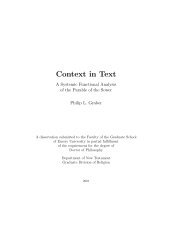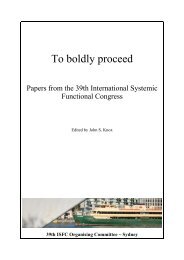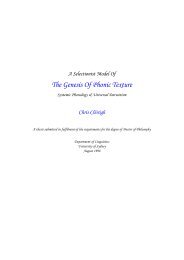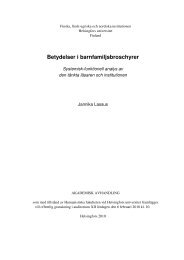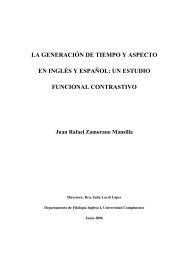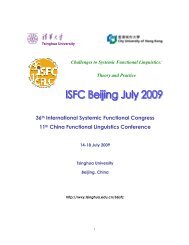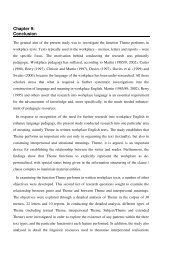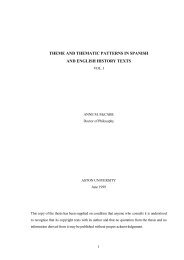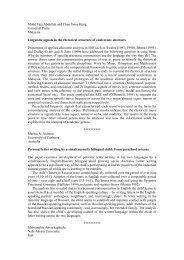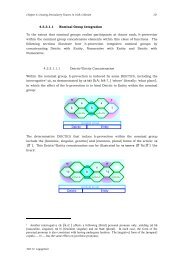Abstracts - Faculdade de Letras da Universidade de Lisboa
Abstracts - Faculdade de Letras da Universidade de Lisboa
Abstracts - Faculdade de Letras da Universidade de Lisboa
- No tags were found...
You also want an ePaper? Increase the reach of your titles
YUMPU automatically turns print PDFs into web optimized ePapers that Google loves.
ROSALICE PINTO, CENTRO DE LINGUÍSTICA DA UNIVERSIDADE NOVA DE LISBOA,PORTUGALRE(CONFIGURATION) OF SOCIAL ACTORS IN MULTIMODAL TEXTSWhen facing empirical <strong>da</strong>ta <strong>de</strong>rived from several social activities, one perceives thatknowledge and information are transmitted through texts (oral and written) thatmobilize various semiotic resources. Therefore, some aspects that were, in a way,neglected by the sciences of language – essentially characterized by a verb centredvision – began being valued by theoreticians that privilege the multimo<strong>da</strong>lcharacter of action. Various text/speech specialists expan<strong>de</strong>d this matter. On onesi<strong>de</strong>, there are specialists that privileged a certain expression plan, such as: Kress &Van Leeuwen (1996) – who are interested by the elements of visual semiotics-; onthe other si<strong>de</strong>, authors that revealed, mainly, an interlace of various systems in aprocess of dynamic construction, like Kress et al. (2001), among others. Due to thecomplexity of questions raised by the multimo<strong>da</strong>l analysis of texts, this work, whichcombines theoretical-methodological aspects of Socio-discursive Interactionism andSystemic Functional Linguistics, aims at showing, primarily, the ways of multimo<strong>da</strong>lexpression existent in two distinct text genres: one advertising and one i<strong>de</strong>a <strong>de</strong>bate.Further on, we will show that the adopted plurisemiotic choices are not random,but generically constricted. Finally, we will point out that the social actors put inscene in these texts are (co)constructed by the combination of multimo<strong>da</strong>lresources at disposal of the text´s producer and we will also <strong>de</strong>scribe them. Withthis contribution, we intend, thus, to indicate some hints that may be used inteaching/learning contexts of curricular units, contributing to the <strong>de</strong>velopment ofteachers and stu<strong>de</strong>nts.ReferencesBronckart, J.-P (2004). Commentaires conclusifs. Pour un développement collectif <strong>de</strong> l´interactionnisme socio-discursif, Calidoscópio 2 (2), p. 113-123.Bronckart, J.-P (2008). Genres <strong>de</strong> textes, types <strong>de</strong> discours, et « <strong>de</strong>grés » <strong>de</strong> langue, Texto ! [Enligne], URL : http://www.revue-texto.net/in<strong>de</strong>x.php?id=86.De Saint-Georges I. (2008). La multimo<strong>da</strong>lité et ses ressources. In L. Filliettaz: I. <strong>de</strong> Saint-Georges, B. Duc , ”Vos mains sont intelligentes!” Interaction en formation professionnelleinitiale. Université <strong>de</strong> Genève: Cahiers <strong>de</strong> la section <strong>de</strong>s sciences <strong>de</strong> l´éducation, 103, pp. 117-158.Filliettaz, L. (2009). Les représentations du travail <strong>da</strong>ns <strong>de</strong>s réunions <strong>de</strong> relève <strong>de</strong> poste enmilieu industriel. Une analyse multimo<strong>da</strong>le. In S. Canelas-Trevisi, M.-C. Guernier, G. SalesCor<strong>de</strong>iro & D. Lee Simon (Ed.), Langage, objets enseignés et travail enseignant (pp. 47-70).Grenoble: ELLUG, p. 47-70.Kress, G. & Van Leeuwen, T. (1996) Reading Images. The Grammar of Visual Design. London:ISFC38 Book of <strong>Abstracts</strong> Page 169 Lisbon, July 2011



